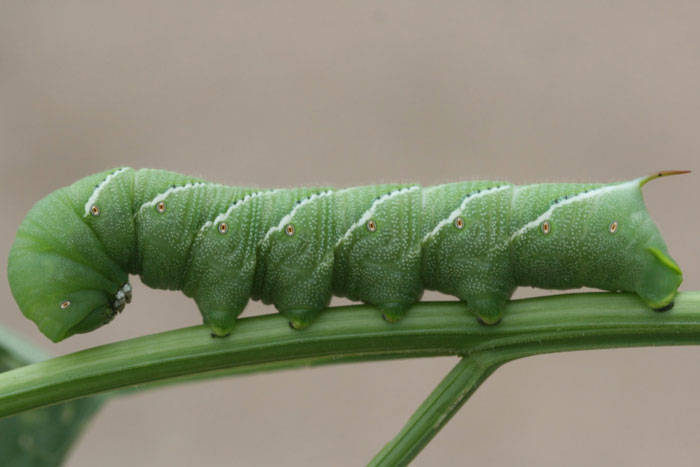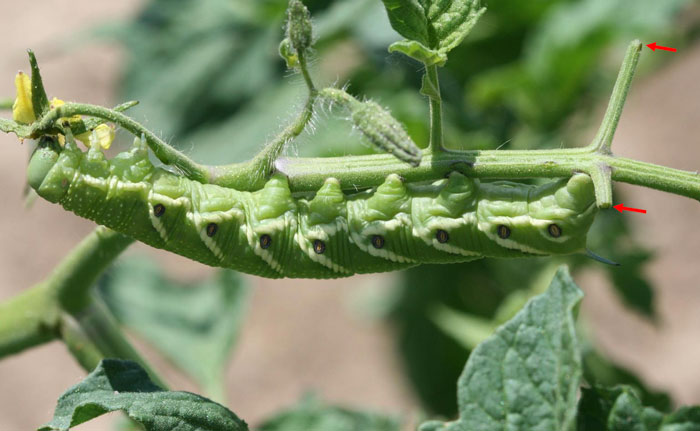Taking an environmentally sensitive approach to pest management
Caterpillars 'Horn In' on Tomato Plants
Published: August 6, 2021
Several types of caterpillars can cause damage to tomato plants in Missouri. However, the tomato hornworm (Manduca quinquemaculata) and the tobacco hornworm (Manduca sexta) are often the most noticeable, measuring up to four inches-long with a prominent "horn" on the last segment of their body (Figure 1). Both types of hornworm caterpillars devour leaves and can completely defoliate tomato plants if left unchecked. Hornworms also chew holes in green tomato fruit, especially during dry weather. These pests also feed on eggplant, pepper, potato, and on weeds, such as horsenettle, jimsonweed, and nightshade.

Figure 1 Tobacco hornworm with its prominent reddish-colored "horn" on a tomato stem. Photo credit: Whitney Cranshaw.
There are usually two generations of hornworms produced each summer. The adult moths emerge in mid- to late spring. Both species are mottled gray-brown moths with four to five-inch wingspans. After mating, females lay their small eggs, which often are undetected, on the upper and lower surface of tomato leaves and other host plants.
After hatching, tomato hornworms undergo five larval or instar stages in three to four weeks. All five instars feed on plants. The first small instar is whitish-yellow with five pairs of prolegs used to grip onto plant stems and leaves. When fully-grown, caterpillars are usually green in color, but dark brown types can also develop. Also, full- grown tomato hornworm caterpillars have V-shaped markings on their sides and usually have a black horn. In contrast, late-instar tobacco hornworm caterpillars have seven diagonal stripes on their body and their horn is usually red (Figure 2). Full-grown caterpillars of the second generation, which develop in mid- to late summer, drop off plants to pupate. Pupae overwinter about five to six inches below the soil surface.

Figure 2 Tomato hornworm on a plant. Note the missing leaves (arrows) after hornworm feeding. Photo credit: Whitney Cranshaw.
To limit hornworm damage, frequently scout for evidence of feeding. Because hornworm caterpillars blend in with the foliage, they often go undetected until severe damage has occurred. Feeding damage generally begins on the upper leaves of tomato plants (Figure 2). Also, dark greenish-black droppings left by caterpillars when feeding often are present on the foliage. Under rapid drying conditions, spraying plants with water disturbs the caterpillars and their movement makes them easier to spot.
When hornworms are found, handpick them from plants and drown them in soapy water. However, first check to see if hornworms are parasitized by small predatory wasps, such as Cotesia congragatus. Wasp larvae feed on the internal organs and fluids of hornworms. Fully-developed wasp larvae form cocoons, which appear as grains of white rice attached to the hornworm. After killing the hornworm, wasps move to other hornworms to parasitize them (see https://bugguide.net). Parasitized hornworms should be left on the plant to increase the population of these beneficial wasps which are harmless to humans.
If hornworms are problematic, low-risk pesticides with active ingredients such as Bacillius thuringiensis (Bt) or Spinosad can be used on very young caterpillars. Insecticidal soap can also be used to control small caterpillars, but the spray must contact the hornworm to be effective. Carbaryl (e.g., Sevin®) or other broad-spectrum insecticides are also available to control hornworms. To reduce future infestations of hornworms, till the soil to a six inch-depth in the fall after harvest to destroy burrowing caterpillars and pupae.
Subscribe to receive similar articles sent directly to your inbox!
- Caterpillars 'Horn In' on Tomato Plants (08/06/21)
- Vanishing Leaves (09/01/11)
REVISED: August 6, 2021